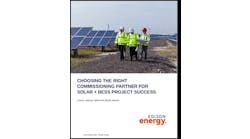We’re seeing watershed events in the energy storage industry, and they’re creating new microgrid markets.
That’s the word from Matt Roberts, executive director of the Energy Storage Association.
Here’s just one example of the many watershed events that are creating opportunities for microgrids: PJM recently created a performance capacity market, where you can bundle together technologies–solar with storage, for instance–and bid them into the market as collective items.
“We’re looking at new opportunities to aggregate and create a virtual microgrid system,” he said. “Microgrids will be a driving force; new markets are being created that open the door for performance and value.”
Another watershed event was the Aliso Canyon gas leakage, which led to an energy storage procurement RFP that’s expected to result in a storage procurement as high as a few hundred megawatts, Roberts said.
Market structures are expected to change in ways that create numerous opportunities for microgrids, said Roberts. The changes focus on giving a value to the benefits of energy storage and microgrids–resiliency, for instance.
“Microgrids have a big role to play in the reliability and resiliency of the system as market structures change,” said Roberts. “We are starting to give value to things like resiliency and flexibility and these systemic, system-wide values that you haven’t been able to get paid for. That’s what’s being unlocked right now.”
Along those lines, PJM has created values for speed and accuracy, which are new values on the grid, he said.
“PJM effectively rewards speed and accuracy through its structure; that’s a new value—you couldn’t get paid for being fast before,” he said. “Now, these systems have millisecond response times and the grid can reward that responsiveness and accuracy.”
But there are additional value streams that need to be opened up, he said. The Energy Storage Association wants to open up resiliency as a value stream. “What is it worth to keep the lights on? There’s no value in the market that rewards that right now.”
Flexibility is another asset that needs to be rewarded. “What’s it worth to be able to call up 10 MW and at the last second, say, ‘I only need 8?'”
Placing a value on such services will boost markets for microgrids, Roberts said. “Microgrids have those value streams built into them. They can export power, island and do demand response.”
The Energy Storage Association and other organizations are calling for opening up these value streams in their responses to FERC Docket No. AD16-20-000, an investigation into energy storage that asks regional transmission operators and independent system operators to identify barriers to the deployment of energy storage in their grid-management territories.
“This is a call for comments from FERC for all ISO markets, which is two-thirds of the country. They have to respond to FERC and say, ‘This is how we value storage,” said Roberts.
The Energy Storage Association hopes for an order from FERC that will help increase access for these capabilities in the market.
“What we’d like is a performance-based market that’s technologically neutral. If I can provide a service that’s cost effective, I should be able to participate in the market. That’s what we’d like to see come out of this,” Roberts said. “That’s the principal that permeates everything else. There are rules that allow storage to provide capacity, for example; it’s already proven storage can do this. It’s a good idea to get everyone to step back and say, ‘This is how storage should work and let’s make it part of our future.'”
Consider other advanced tech too, says AEE
Meanwhile, the Advanced Energy Economy (AEE) applauded FERC for initiating a formal inquiry into the barriers to participation of energy storage in regional electricity markets.
In comments filed with FERC, in its proceeding, “Electric Storage Participation in Regions with Organized Wholesale Electric Markets,” AEE asked the commission to conduct a separate review of market rules that keep other advanced energy technologies from meeting customer demand and improving grid reliability and resiliency.
“We wholeheartedly applaud this FERC inquiry, as energy storage technology has proven to be a practical and cost-effective resource. We call on FERC to quickly take steps through this inquiry to address the rules that prevent its broader use,” said Arvin Ganesan, vice president for federal policy for Advanced Energy Economy. “However, since the same challenges exist for a wide variety of other technologies, we urge FERC to identify the barriers to participation in wholesale markets that are facing all advanced energy technologies.”
AEE identified three traits of market rules and tariffs that impede the participation of energy storage and other advanced energy technologies in wholesale markets.
The first is defining eligibility to enter the market based on resources types, instead of what a technology can do. This bans from competition new technologies that can accomplish the same purpose as other resource types, according to the press release.
Second, effectively requiring that all participating resources resemble traditional power plants excludes a resource like energy storage because it is unavailable when recharging.
And third, characterizing all technologies installed behind the customer’s meter only as demand response is a barrier, said AEE. This prevents resources like on-site storage, solar and fuel cells from providing a broader set of services to the grid, AEE said.
The Energy Storage Association announced last week that the U.S. deployed 18.3 MW of energy storage in the first quarter of 2016. Deployments were up 127 percent year-over-year but down 84 percent from 2015’s historic fourth quarter,” according to the association.
Track news about microgrid markets by subscribing to the Microgrid Knowledge newsletter. It’s free.







